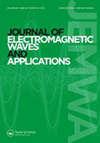An optically transparent coplanar L-probe fed antenna based on capacitively coupled array of patches
IF 1.2
4区 工程技术
Q4 ENGINEERING, ELECTRICAL & ELECTRONIC
Journal of Electromagnetic Waves and Applications
Pub Date : 2023-11-06
DOI:10.1080/09205071.2023.2277188
引用次数: 0
Abstract
AbstractAn optically transparent antenna fed by a coplanar L-probe is proposed in this paper. Indium-doped tin oxide (ITO) with a sheet resistance of 3.5 Ω/sq etched on a soda-lime glass substrate is used as radiation array and ground to achieve high optical transmittance. TM10 and TM20 modes are excited simultaneously to expand work bandwidth. The fabricated antenna achieves a –10 dB reflection bandwidth of 27.5% from 4.7 to 6.2 GHz with the overall size of 42 mm × 42 mm × 3.3 mm. Different from many antennas composed of ITO, the proposed antenna exhibits directional radiation patterns with the maximum realized gain of 4.6 dBi and the maximum efficiency of 61%. Meanwhile, the optical transmittance of the antenna can reach above 58%.Keywords: Optical transmittanceantennagainindium-doped tin oxide (ITO) Disclosure statementNo potential conflict of interest was reported by the author(s).Additional informationFundingThis work was supported by the Shaanxi Natural Science Basic Research Project of Shaanxi science and Technology Office[No. 2023-JC-QN-0673]the National Natural Science Foundations of China[No. 61971340 and 62122061].Notes on contributorsPingle LiangPingle Liang received the B.E. degree in electronic and information engineering from Chongqing University, Chongqing, China, in 2021. He is currently working toward the M.E. degree in Information and communication Engineering with the School of Information and communications Engineering, Xi'an Jiaotong University, Xi'an, China. His research interests include optically transparent antennas and ground penetrating radar antennas.Juan ChenJuan Chen was born in Chongqing, China. She received the Ph.D. degree from Xi'an Jiaotong University, Xi'an, China, in 2008, in electromagnetic field and microwave technology. She is currently working in Xi'an Jiaotong University, Xi'an, China, as a professor. Her research interests include the computational electromagnetics, microwave device design, etc.一种基于电容耦合贴片阵列的光学透明共面l探针馈电天线
摘要本文提出了一种共面l型探头馈电的光学透明天线。将电阻为3.5 Ω/sq的铟掺杂氧化锡(ITO)蚀刻在钠石灰玻璃基板上作为辐射阵列和地面,以实现高透光率。同时激励TM10和TM20模式,扩大工作带宽。该天线在4.7 ~ 6.2 GHz范围内的反射带宽为-10 dB,为27.5%,整体尺寸为42 mm × 42 mm × 3.3 mm。与许多ITO构成的天线不同,该天线具有定向辐射方向图,最大实现增益为4.6 dBi,最大效率为61%。同时,天线的透光率可达58%以上。关键词:光学透射;天线;铟掺杂氧化锡(ITO)披露声明作者未报告潜在利益冲突。项目资助:陕西省科技厅自然科学基础研究项目[No. 1];国家自然科学基金项目[2023-JC-QN-0673];[61971340和62122061]。梁平乐,2021年毕业于中国重庆大学,获电子与信息工程学士学位。他目前在西安交通大学信息与通信工程学院攻读信息与通信工程硕士学位,中国西安。主要研究方向为光学透明天线和探地雷达天线。陈娟,出生于中国重庆。2008年获西安交通大学电磁场与微波技术博士学位。现就职于中国西安交通大学,任教授。主要研究方向为计算电磁学、微波器件设计等。
本文章由计算机程序翻译,如有差异,请以英文原文为准。
求助全文
约1分钟内获得全文
求助全文
来源期刊
CiteScore
3.60
自引率
7.70%
发文量
116
审稿时长
3.3 months
期刊介绍:
Journal of Electromagnetic Waves and Applications covers all aspects of electromagnetic wave theory and its applications. It publishes original papers and review articles on new theories, methodologies, and computational techniques, as well as interpretations of both theoretical and experimental results.
The scope of this Journal remains broad and includes the following topics:
wave propagation theory
propagation in random media
waves in composites and amorphous materials
optical and millimeter wave techniques
fiber/waveguide optics
optical sensing
sub-micron structures
nano-optics and sub-wavelength effects
photonics and plasmonics
atmospherics and ionospheric effects on wave propagation
geophysical subsurface probing
remote sensing
inverse scattering
antenna theory and applications
fields and network theory
transients
radar measurements and applications
active experiments using space vehicles
electromagnetic compatibility and interferometry
medical applications and biological effects
ferrite devices
high power devices and systems
numerical methods
The aim of this Journal is to report recent advancements and modern developments in the electromagnetic science and new exciting applications covering the aforementioned fields.

 求助内容:
求助内容: 应助结果提醒方式:
应助结果提醒方式:


